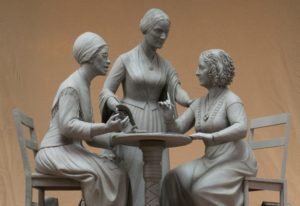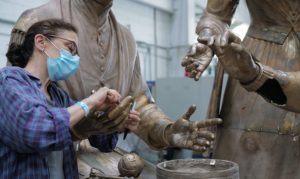The first statue to honor women in New York’s Central Park
The first statue to honor women in New York’s Central Park will feature Sojourner Truth, Susan B. Anthony and Elizabeth Cady Stanton.

This year marked the centennial of the ratification of the 19th Amendment that gave white women the right to vote.
And next week will mark another first: Sculptor Meredith Bergmann will unveil Central Park’s first statue to depict real women, a 14-foot-tall bronze monument paying homage to Sojourner Truth, Susan B. Anthony and Elizabeth Cady Stanton — all of whom were at the forefront of the national suffrage movement.
Both Stanton and Anthony strongly opposed the ratification of the 15th Amendment, which granted Black men the right to vote. Stanton made it clear in her fight for voting rights that when she said women, she meant white. Black suffragists were often told to march at the back of a protest.
Yet Sojourner Truth, who was formerly enslaved, carried her fight against slavery into the suffrage movement with her famous “Ain’t I a Woman?” speech and worked with Anthony and Stanton despite severe differences in opinion over Black Americans’ right to vote.
In her larger-than-life sculpture, Bergmann imagines what their meeting would have looked like. She says she had to do some digging to get inside their heads in order to portray them accurately.
Bergmann has done the historical deep dive before behind the Boston Women’s Memorial that features Abigail Adams, Phillis Wheatley and Lucy Stone.
In her new Women’s Rights Pioneers Monument in Central Park, Bergmann has Anthony, Truth and Stanton seated or standing around a table. Both at the edge of their seats, Truth has her hands open and Stanton has a pen and paper as if they are strategizing their next move. But the interpretation of the conversation depicted in the monument is up to the individual viewer, she says.
There are little hidden surprises as well. Stanton’s dress has sunflower motifs, a symbol from when the young suffragist began to write and publish editorials under the pseudonym “Sunflower” to avoid the disapproval of her family.
Sculptor Meredith Bergmann will soon unveil Central Park's first statue to depict real women, a 14-foot-tall bronze monument paying homage to Sojourner Truth, Susan B. Anthony and Elizabeth Cady Stanton. @hereandnow https://t.co/yoLaAyKtle
— NPR (@NPR) August 23, 2020
Having the legendary women together in the same frame of reference is important because “each of them in their own way was so central” to the movement, Ware says. Truth also provides a critical point of intersection with the abolition movement.
“I think the power of having these three women together is that it shows the roots of women’s suffrage and women’s rights in the struggle to free the slaves,” Ware says. “No better symbol of that than Sojourner Truth.”
Black women, who were a part of the women’s suffrage movement, didn’t benefit from the 19th Amendment. Ware says in the South, where many Black Americans resided, the same Jim Crow restrictions that kept Black men away from the polls also prevented Black women from voting.

“It’s very important as we mark this milestone in women’s history, to remember that it is an incomplete one, that it really has an asterisk with it, and that for African American women, it was the Voting Rights Act of 1965, not the 19th Amendment, that finally guaranteed their right to vote,” Ware says.
As the day nears to reveal the Women’s Rights Pioneers Monument in person, Bergmann says the process of sculpting these women was both “daunting” and “awe-inspiring.” She says she crafted the monument three times, getting bigger and bigger each time.



